Spectral Flow Cytometry: A Detailed Scientific Overview
What is Spectral Flow Cytometry?
Spectral flow cytometry is an advanced analytical technique that enhances traditional flow cytometry by capturing the complete emission spectra of fluorochromes. Unlike conventional flow cytometry, which uses dichroic mirrors and discrete bandpass filters to measure specific wavelengths, spectral flow cytometry captures a variety of points across the entire emission spectrum of each fluorochrome1 (Figure 1). Therefore, spectral flow cytometers usually involve more detectors than fluorochromes, unlike the one-detector-per-fluorochrome approach in traditional bandpass flow cytometry. Consequently, spectral flow cytometry allows for precise characterization of multiple parameters simultaneously, enhancing flexibility and accuracy in experimental design and data interpretation.
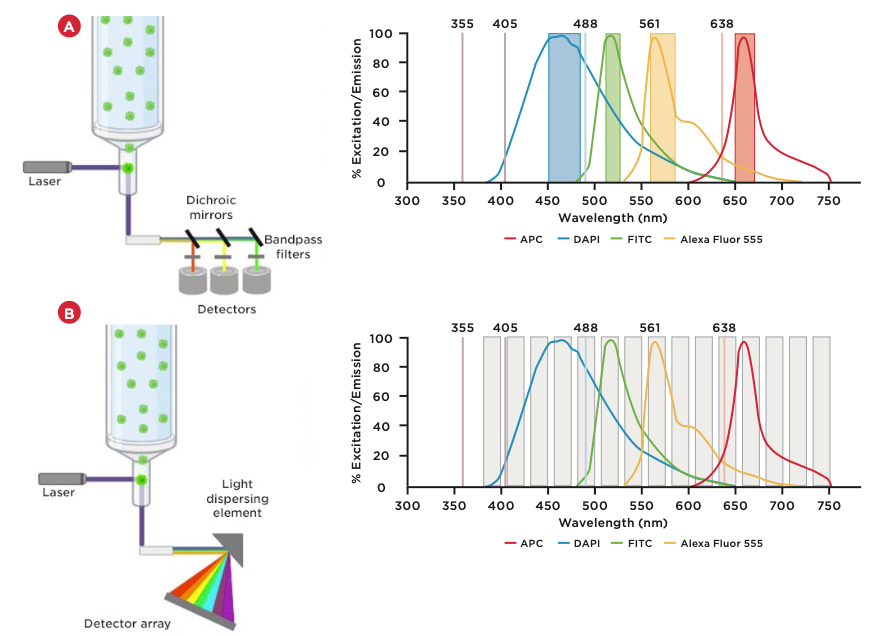
Figure 1. An illustration of the key differences in the conventional and spectral flow cytometry: (A) Represents the optical layout of a traditional bandpass flow cytometer, with each detector measuring a fraction of emission of each fluor. (B) A spectral flow cytometer uses multiple detectors to collect full spectrum fluorescence emission for all fluorochromes using multi-laser excitation.
Why Use Spectral Flow Cytometry?
Increased Adoption of High-Parameter Cell-Based Testing
- Complexity of the Immune System-Spectral flow cytometry’s multiplexing capabilities, due to its ability to distinguish between multiple fluorophores with overlapping spectra, enable high-dimensional analysis required for comprehensive immune system characterization. By simultaneously detecting multiple markers, it facilitates a nuanced understanding of immune cell subsets, their functions, and interactions. For instance, studies like OMIP-102 use up to 50 different colors in a single tube for immunophenotyping cells from human peripheral blood.2
- Disease Understanding-Spectral flow cytometry can help in better profiling of multiple disease parameters simultaneously.3For instance, in fields such as oncology, spectral flow cytometry aids in elucidating disease complexities by enabling simultaneous profiling of multiple markers for tumor cells and the immune microenvironment. This can reveal insights into tumor heterogeneity and immune evasion mechanisms, potentially identifying novel therapeutic targets.
Autofluorescence removal
- One of the significant challenges in flow cytometry is interference caused by autofluorescence from cellular components. Spectral flow cytometry can treat autofluorescence as a signal to be subtracted, enhancing dim fluorescent signals.4
Separating dyes with similar emission
- Spectral flow cytometry offers a significant advantage by resolving fluorochromes with similar emission maxima but distinct off-peak spectra, thereby allowing for the inclusion of a greater variety of fluorochromes in a single experiment. This capability increases the number of parameters that can be analyzed concurrently. For example, APC and Alexa Fluor 647 have nearly identical peak emission wavelengths but exhibit different off-peak emissions. Spectral flow cytometry leverages these unique spectral signatures, enabling both dyes to be used in the same panel without interference, thus enhancing analytical precision and versatility (Figure 2).


Figure 2. Represents difference in emission profile of 2 highly overlapping dyes in far red region – APC and Alexa fluor 647 (A) Emission profiles of APC and Alexa Fluor 647 showing a great degree of overlap (B) Spectral signature of both these dyes APC (blue) and Alexa fluor (red) showing unique characteristics and differences which makes it possible for users to use them in the same spectral experiment.
A Step-by-Step Guide on How to Use Spectral Flow Cytometry
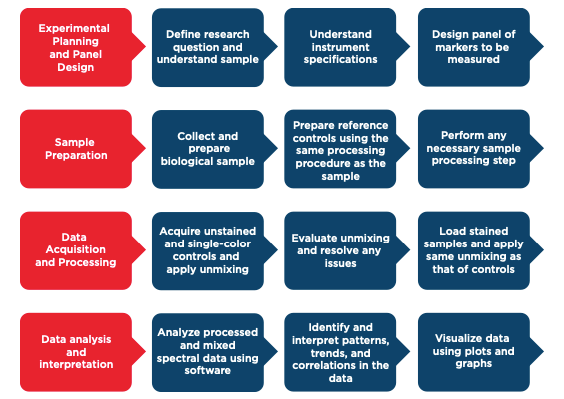
Figure 3. Steps required to perform a spectral flow experiment.
While it follows the general rules of sample preparation, run and data analysis as conventional flow cytometry, spectral flow cytometry requires several additional considerations.
-
Experimental Planning and Panel Design: Considerations and Differences with Conventional Flow
Cytometry.
Know your instrument
Traditional flow cytometers typically incorporate up to 6-7 lasers and 20-25 detectors, making them suitable for many routine applications but limited in analyzing complex samples with multiple fluorochromes. In contrast, spectral flow cytometers collect emitted light at multiple points across the visible spectrum for each fluorochrome enabling collection of the nearly complete fluorescence spectrum from each fluorochrome. This generates a unique spectral signature for each fluorochrome, facilitating a more comprehensive and detailed analysis of complex samples.
Light from different lasers illuminates target cells, and the emitted light is routed to various detector modules, using either photomultiplier tubes (PMTs) or avalanche photodiode (APD)- based detectors, depending on the manufacturer of the spectral instrument. While PMTs are highly sensitive across a broad range of wavelengths, APDs offer high quantum efficiency, particularly in the far-red region of the spectrum.5 Proper instrument settings, including laser power and alignment, detector and gain calibration with standardized beads, sensitivity and linearity verification, daily performance checks, and appropriate data acquisition settings, are important for accurate results. Antibody capture beads, commonly used in conventional flow cytometry, are similarly used for calibration in spectral flow cytometry.
Understanding the sample
Designing a panel requires a thorough understanding of the sample's biology, and meticulous assay optimization. This includes sample preparation, antibody titration, antigen blocking, control selection, staining protocol validation, and optimization of acquisition settings. Like traditional workflows, spectral workflows start by identifying specific cell populations and markers for analysis. Proper sample processing to achieve a single-cell suspension with high viability is crucial for flow cytometry. Sample type, cell concentration, and staining volumes must be tailored to the instrument in use. Optimal antibody concentrations and necessary controls—such as unstained, single-stain, and Fluorescence Minus One (FMO) controls—are needed for accurate baseline setting and gating.
Considerations for panel design
Based on the research question, users can design a panel of fluorochromes that would be best suited for the experiment. Panel design for spectral flow cytometry refers to selecting the right combination of fluorochromes compatible with the spectral flow cytometer, considering spectral overlap and the need for unmixing. Unlike conventional flow cytometry, where minimizing spectral overlap is a primary concern, spectral flow cytometry allows for more flexibility in fluorochrome selection due to its unmixing capabilities, and panels are generally bigger when compared to conventional flow cytometry. Various tools such as FluoroFinder, FlowJo, FCS Express etc. are available to optimize panels by analyzing many markers and fluorophore combinations. Generally, when designing a panel, it is important to consider:6,7
- Full spectral emission profiles of each fluorochrome and potential overlaps. Spectral flow cytometry resolves closely overlapping fluorescence signals, although the best performance is achieved when fluorescence spectra exhibit greater spectral separation. Effective use of this technique requires careful fluorochrome selection, considering compatibility with the spectral flow cytometer and full emission spectra to minimize overlap. It is important to refer to spectral reference guides (depending on the instrument) to select fluorochromes with distinct spectral signatures.
- Expression levels of the markers incorporated into the panel. Markers with high expression should be conjugated with dimmer fluorochromes such as FITC, Pacific orange etc. to prevent them from overshadowing other markers and adding to spreading error (SE). Conversely, markers with low expression should be conjugated with brighter fluorochromes such as APC, PE, BV421 etc. to enhance their detectability. Pan markers should be assigned to the lowest spillover detector while unique markers should be assigned to the highest spillover detector. Additionally, users should avoid using fluorochromes with significant spectral overlap for co-expressed markers on cells.
- Choose validated antibodies conjugated to your chosen fluorochromes while ensuring that each antibody specifically binds to its target antigen.
- If using tandem dyes, researchers must try to employ the latest dyes—and protect them from light or chemically induced degradation.
- The Stain Index (SI) measures the resolution of a particular fluorophore's signal from background noise. It should be given due consideration while designing a spectral flow cytometry panel to have better fluorochrome resolution and reduce spreading error.
- It is important to add a viability dye to the panel to gate out the dead cells that can impact data quality.
- Consider starting by choosing simpler panels and gradually increasing complexity by adding fluorochromes with unique signatures.
- Accurately defining highly autofluorescent cell populations is important for panel optimization because unstained cells might contain several endogenous fluorophores that have a unique spectral signature, which can result in heterogeneous autofluorescence from such populations. When it is not possible to eliminate autofluorescence from all channels, cells with the highest levels of autofluorescence can be assigned to a separate channel.
- Finally, users must perform antibody titration to determine the optimal concentration of each antibody before proceeding with the final optimized experiment on the spectral flow cytometer.
Selecting fluorochromes can be a challenging task due to the significant impact that differences in resolution and spillover have on panel performance and data interpretation. Spreading error (SE) can pose challenges in accurately distinguishing between negative and positive populations within a detector. Effective panel design mitigates the impact of SE, as the degree of spreading error can vary among fluorophores and across different detectors. Careful optimization is required to ensure precise and reliable measurement by minimizing the influence of SE on signal detection and resolution.
Spectral cytometry panels can be computationally evaluated using similarity index analysis to compare 2 signatures. Similarity between fluorochrome emissions and extracted autofluorescence emissions, or two populations with similar autofluorescence characteristics, can be analyzed on a 0 to 1 scale (0: no similarity, 1: fully overlapping spectra) to make more informed choices for selecting correct fluorochromes. Resources such as FluoroFinder enable analysis of fluorophore emission spectra at various excitation wavelengths, facilitating the construction of a spectral similarity matrix to understand the similarity between fluorophores that can be used together in a spectral experiment.
For instance, in an example spectral panel (Figure 4), FITC and Brilliant Blue 515 have a similarity index of 0.99, which indicates nearly overlapping spectra. Interestingly, APC and Alexa Fluor 647 have a spectral overlap of 0.86, which indicates that, though these two fluorochromes cannot be used together in traditional flow cytometry, their unique spectral signature makes them distinguishable in spectral flow cytometry. Additionally, another parameter called complexity index focuses on the overall difficulty of a panel design, considering multiple aspects of panel setup. The goal of assessing complexity is to ensure that the panel is feasible and can efficiently minimize spreading error. A low to moderate complexity index indicates panel feasibility, while a high complexity index shows that the panel is complicated and could benefit from simplification.
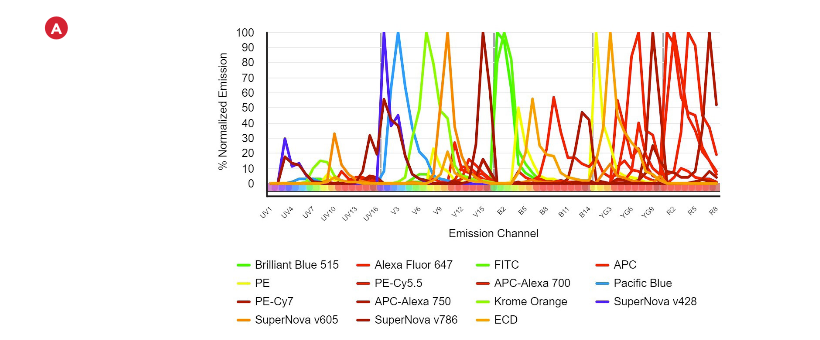
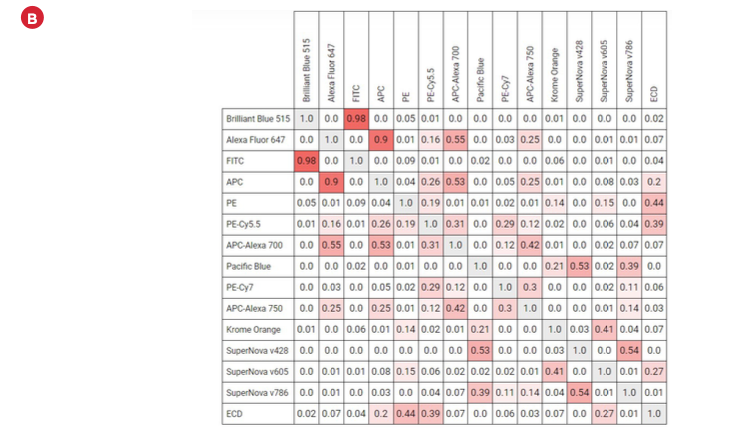
Figure 4. (A) Spectral signatures and similarity matrix for 15 fluorochromes that can be used together in a spectral flow experiment. (B) A higher similarity index indicates higher overlap in spectral signatures, indicating more attention is needed for including them together in the single panel. Lower values indicate lesser similarities in spectral signatures (source: https://fluorofinder.com/).
-
Sample Preparation and Importance of Selecting Appropriate Controls
Sample preparation
Sample preparation for spectral flow cytometry requires attention to minimizing spectral overlap and optimizing multiparametric analysis, unlike conventional flow cytometry, which typically deals with fewer parameters and simpler compensation requirements. Key steps include selecting appropriate anticoagulants, cell fixation, staining and washing. Optimizing these procedures enhances consistency and reduces background noise and autofluorescence.
Pre-analytical factors such as sample collection, isolation, and storage are essential for achieving high-quality single-cell suspensions and successful experimental outcomes. Ensuring high cell viability, retention of cell surface markers, and low debris levels—accomplished through multiple washing steps—is important for high-quality data.
To effectively remove red blood cells and debris, determine the optimal lysis procedure: no lyse/no wash, lyse/no wash, or lyse/wash. Avoid over-lysis to preserve sample integrity and carefully select the lysis buffer. Post-lysis, optimize fixation or permeabilization for intracellular staining to ensure adequate marker detection and high staining quality.9,10
Reference controls
Controls are important in spectral flow cytometry for accurate unmixing. Users must include single- stain controls for each fluorochrome to capture unique spectral signatures. Additionally, unstained and autofluorescence controls are necessary to distinguish specific signals from background noise, ensuring precise results. Controls used in spectral experiments are:
- Single-color controls:To avoid unmixing errors and false positives, the control must match the
spectral signature of the multicolor sample. Both cells and beads should be tested to identify
the most accurate control for the fluorochrome’s spectral signature.
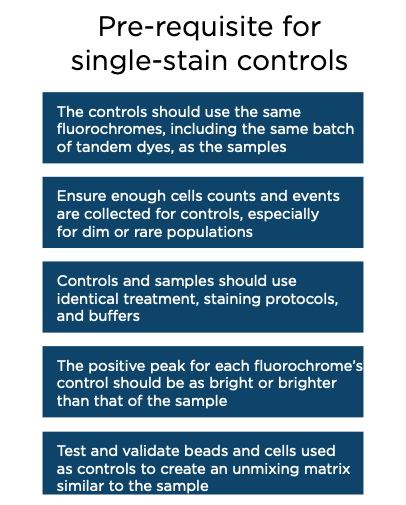
Figure 5. Pre-requisites for single-stain controls used in spectral flow cytometry.
- Unstained controls:An unstained cell control is important for measuring cellular autofluorescence, which varies by cell type and physiological conditions. It also aids in setting gating parameters for forward and side scatter. Using an unstained cell control that matches the experimental conditions helps unmixing algorithms separate autofluorescence from other spectral signatures, enhancing sensitivity and the detection of weakly positive cell populations.
- Viability dye control:A viability dye control distinguishes between live and dead cells in experiments, ensuring accurate interpretation of results by identifying non-viable cells that could affect data quality.
- In addition, it is recommended to use Fluorescence Minus One (FMO) controls when setting up the assay for the first time in spectral flow cytometry. Isotype controls can also be used if relevant to the study.9
- Single-color controls:To avoid unmixing errors and false positives, the control must match the
spectral signature of the multicolor sample. Both cells and beads should be tested to identify
the most accurate control for the fluorochrome’s spectral signature.
- Data acquisition and processing
Flow cytometers measure the amount of incident photons produced by fluorescent moieties. Spectral cytometry quantifies the whole fluorescence spectrum of individual cells by recording the total emission throughout the whole range of wavelengths of visible light. Post-detection, electronics gather, amplify, and digitize the electronic signal. Subsequently, the multicolor data is divided into many channels to provide an analysis of the individual contribution of each fluorochrome. Additionally, data processing is also important and there are several parameters that differentiate data processing in spectral vs. conventional flow cytometry.
Sample preparation
Each fluorochrome shows a unique spectral signature which is a detailed "fingerprint" that represents how the fluorochrome's emitted light is distributed across the spectrum. It is represented by plotting the signal intensity on the y axis and density distribution of the events occurring at every detector on the X axis. The color gradient—from red (indicating high intensity) to blue (indicating low intensity)— depicts the distribution of fluorescence. This allows for the differentiation of fluorochromes, even those with overlapping emission spectra, by illustrating the specific wavelengths at which each fluorochrome emits most strongly. To compare spectral signatures between 2 or more fluorochromes, users should normalize the signatures and compare their overall shapes.
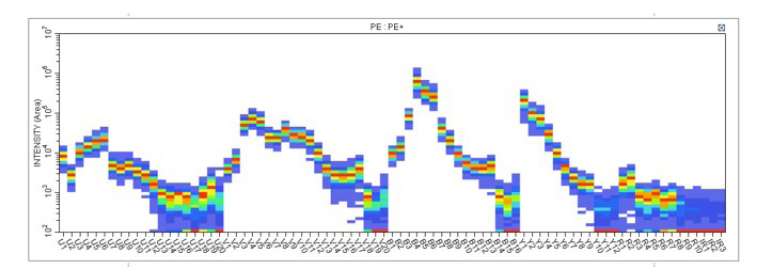
Figure 6. Spectral signature of PE dye is shown using a CytoFLEX mosaic spectral detection module with a flow cytometer equipped with 6 lasers and having 88 detectors.
Data processing - unmixing vs. compensation
One of the major differences between conventional and spectral flow cytometry lies in the way the contribution of each fluorochrome is separated from similar signals (Figure 7). While conventional flow cytometers use compensation to correct for overlapping spectra from adjacent fluorochromes to isolate individual contribution, spectral flow cytometers use deconvolution to unmix collected light intensity into the spectral contribution of each fluorochrome.9
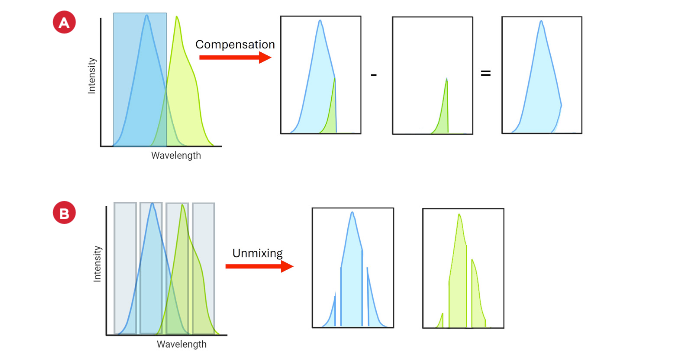
Figure 7. Graphical representation of differences between compensation used in traditional flow cytometry and unmixing used in spectral flow cytometry. (A)Graph on the left side shows overlapping spectra of 2 fluorescent signals (for example, from different fluorophores). After compensation, the overlapping signal, as seen for the blue detector, is adjusted by reducing the interference from spillover.(B)Graph on the left side shows data being captured by a spectral flow cytometer where unmixing process uses more detectors than fluorophores to deconvolute signals, showing individual isolated spectra for each fluorophore.
Compensation and unmixing are important for analyzing multicolor flow cytometry data. These methods correct spectral overlap and separate different fluorescent signals, usually done automatically by specialized software. Proper implementation ensures accurate data and correct marker identification. Compensation uses the spillover matrix, while spectral unmixing uses reference spectra for calculations. In unmixing, each fluorochrome's emission spectrum is recorded in a spectral library. When a fully stained sample is measured, the total fluorescence is the sum of emissions from all the fluorochromes used. To determine the exact contribution of each fluorochrome to the total signal, a spectral unmixing algorithm is applied, such as ordinary least squares and weighted least squares. 10, 11 For more information on various unmixing algorithm, please visit: Unmixing algorithms
Autofluorescence removal
Autofluorescence is natural light emitted by cells when excited by the appropriate wavelength of light, and it can be a potential source of background in flow measurements.12 In conventional flow cytometers, an autofluorescence effect can be mitigated by selecting channels that do not overlap with autofluorescent emissions, or using fluorochromes that are brighter than the cellular. In the case of high autofluorescence, which interferes with the analysis of dim signals, users can choose to remove it with spectral flow cytometry, as this method generates a distinct spectral signature for autofluorescence that can be unmixed from the spectra of other fluorochromes. This can improve resolution and help in analyzing dim and rare cell populations. For more information on dealing with autofluorescent samples using spectral flow cytometry, please visit: Autofluorescence
- Data Analysis and Interpretation
Spectral flow cytometry analysis allows for the simultaneous examination of an increasing number of markers at a single-cell level, which can generate high-dimensional data. With traditional 2D manual gating, the number of plots increases exponentially with each added parameter, limiting our ability to fully explore the data.
Automated analysis methods offer an unbiased approach to exploring complex data, aiding in the discovery of unknown cell populations and the consistent comparison of different population groups. Recently, dimensionality reduction algorithms such as t-distributed stochastic neighbor embedding (t-SNE) and hierarchical stochastic neighbor embedding (h-SNE) have been used to facilitate the visualization of large datasets. Techniques like t-SNE and Uniform Manifold Approximation and Projection (UMAP) reduce dimensionality by positioning cells with similar phenotypes (expressing similar marker levels) closer together on a 2D map, thereby creating clusters that represent subpopulations with known characteristics.
t-SNE is particularly effective at preserving local structures, making it ideal for identifying clusters in flow cytometry data. Conversely, UMAP maintains both local and global structures, providing a more comprehensive view of data relationships. Additionally, UMAP is faster and more scalable, making it well-suited for larger datasets. Both methods are important for exploratory data analysis, uncovering hidden patterns and insights in complex datasets.
Unsupervised clustering algorithms like Spanning-tree Progression Analysis of Density-normalized Events (SPADE) and FlowSOM (Self-Organizing Map) further enhance our ability to interpret complex datasets. SPADE helps in multidimensional analysis of heterogeneous samples, as it creates a tree structure by clustering similar cells into a hierarchy. This helps in representing different cell populations and their relationships, allowing for a comprehensive visualization of cellular hierarchies and pathways. FlowSOM, on the other hand, organizes cells into a grid based on their similarities, making it easier to identify and compare different cell subsets.
SPADE and FlowSOM, while powerful for clustering, require careful parameter tuning and interpretation of results. Some of these tools are now available in flow cytometry software like Cytobank. 13Another interesting tool is CITRUS (Cluster Identification, Characterization, and Regression). CITRUS is an automated pipeline designed to identify statistically significant differences between groups, making it a powerful tool for comparative studies, such as identifying immune cell subsets that differ between healthy and diseased states.
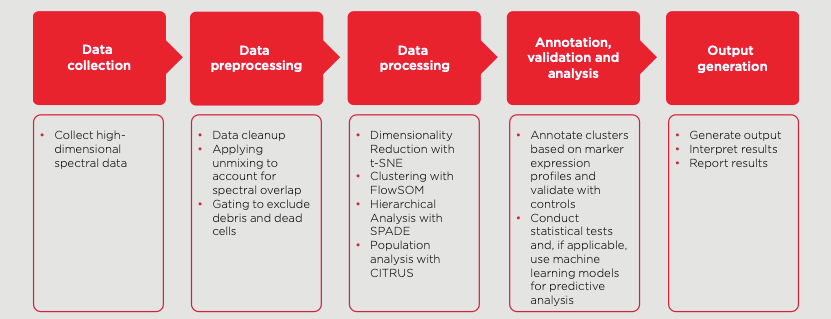
Figure 8. The general data analysis workflow for spectral flow cytometry with high-dimensional data involves data acquisition, pre-processing, data cleaning, dimensionality reduction, clustering analysis, annotation and validation, statistical analysis, visualization and interpretation.
Each tool has its strengths and challenges, and is often designed for specific purposes. Understanding different analytical tools helps in selecting the right one for the research question. While manual gating is useful for testing basic hypotheses, validating findings, and evaluating data quality, computational analysis of complex flow cytometry datasets can deepen our understanding of the immune system and biological complexity that would be challenging to detect using traditional methods alone.12,13
Advantages of conventional and spectral flow cytometry
Conventional flow cytometry is characterized by a simpler setup, making it highly suitable for less complex panels. Its widespread availability and well-established nature are bolstered by a wealth of historical data and standardized protocols, making it a reliable choice for many applications. In contrast, spectral flow cytometry offers superior resolution and accuracy, particularly when handling complex multicolor panels. This advanced technique excels at resolving closely related fluorochromes and managing autofluorescence, thereby making it exceptionally effective for high-parameter analyses.
Conclusion
Spectral flow cytometry provides multiplexing capabilities and can be used for detailed cellular analysis. By capturing the full emission spectra of fluorochromes, this technology allows for a more detailed and precise characterization of cellular properties. Mastering its principles, advantages and methodologies empowers researchers to fully leverage spectral flow cytometry, thereby advancing our understanding of complex biological systems and diseases.
Refrences
- Cossarizza, A., et al. 2021. “Guidelines for the Use of Flow Cytometry and Cell Sorting in Immunological Studies (Third Edition).” European Journal of Immunology 51, no. 12: 2708–3145.
- Konecny AJ., et al. 2024. “OMIP-102: 50-color phenotyping of the human immune system with in- depth assessment of T cells and dendritic cells”. Cytometry A. 105(6):430-436.
- Ferrer-Font, L., et al. 2020. “Panel Design and Optimization for High-Dimensional Immunophenotyping Assays Using Spectral Flow Cytometry.” Current Protocols in Cytometry 92, no. 1: e70.
- Lawrence, W., et al. 2008. “A Comparison of Avalanche Photodiode and Photomultiplier Tube Detectors for Flow Cytometry.” In Proceedings of SPIE, Vol. 6859.
- Lokwani, R., et al. 2022. “Spectral Cytometry on Highly Autofluorescent Samples.” Nature Reviews Methods Primers 2: 71.
- Monici, M. 2005. “Cell and Tissue Autofluorescence Research and Diagnostic Applications.” Biotechnology Annual Review 11: 227–256.
- Niewold, P., et al. 2020. “Evaluating Spectral Cytometry for Immune Profiling in Viral Disease.” Cytometry A 97, no. 11: 1165–1179.
- Nolan, J. P., and D. Condello. 2013. “Spectral Flow Cytometry.” Current Protocols in Cytometry 1: 1.27.1–1.27.13.
- Novo, D. 2022. “A Comparison of Spectral Unmixing to Conventional Compensation for the Calculation of Fluorochrome Abundances from Flow Cytometric Data.” Cytometry A 101, no. 11: 885–891.
- Park, L. M., et al. 2020. “OMIP-069: Forty-Color Full Spectrum Flow Cytometry Panel for Deep Immunophenotyping of Major Cell Subsets in Human Peripheral Blood.” Cytometry A 97, no. 10: 1044–1051.
- Sharma, S., et al. 2024. “A Practitioner’s View of Spectral Flow Cytometry.” Nature Methods 21, no. 5: 740–743.
- Siddiqui, S., and F. Livák. 2023. “Principles of Advanced Flow Cytometry: A Practical Guide.” In Methods in Molecular Biology, Vol. 2580, 89–114.
For Research Use Only. Not for use in diagnostic procedures.

